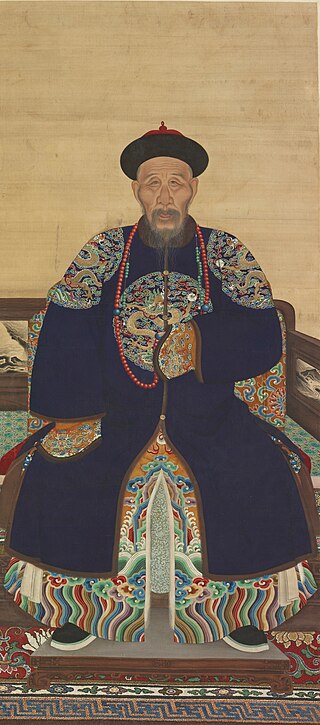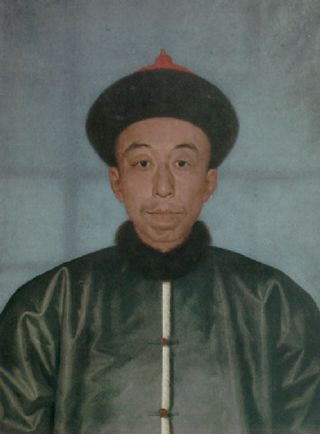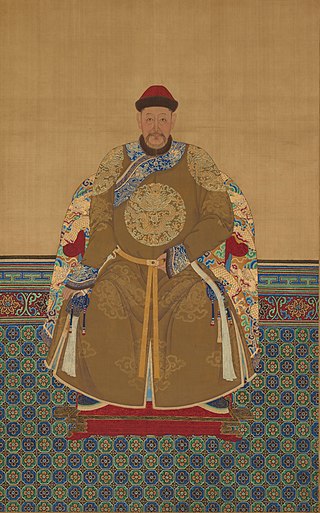Related Research Articles

Yunti, born Yinzhen and also known as Yinti before 1722, formally known as Prince Xun, was a Manchu prince and military general of the Qing dynasty.

Prince Guo of the First Rank, or simply Prince Guo, was the title of a princely peerage used in China during the Manchu-led Qing dynasty (1644–1912). As the Prince Guo peerage was not awarded "iron-cap" status, this meant that each successive bearer of the title would normally start off with a title downgraded by one rank vis-à-vis that held by his predecessor. However, the title would generally not be downgraded to any lower than a feng'en fuguo gong except under special circumstances.
Prince He of the First Rank, or simply Prince He, was the title of a princely peerage used in China during the Manchu-led Qing dynasty (1636–1912). As the Prince He peerage was not awarded "iron-cap" status, this meant that each successive bearer of the title would normally start off with a title downgraded by one rank vis-à-vis that held by his predecessor. However, the title would generally not be downgraded to any lower than a feng'en fuguo gong except under special circumstances.

Prince Qing of the First Rank, or simply Prince Qing, was the title of a princely peerage used in China during the Manchu-led Qing dynasty (1636–1912). It was also one of the 12 "iron-cap" princely peerages in the Qing dynasty, which meant that the title could be passed down without being downgraded.

Daišan was an influential Manchu prince and statesman of the Qing dynasty.
Prince An of the First Rank, or simply Prince An, was the title of a princely peerage used in China during the Manchu-led Qing dynasty (1644–1912). As the Prince A peerage was not awarded "iron-cap" status, this meant that each successive bearer of the title would normally start off with a title downgraded by one rank vis-à-vis that held by his predecessor. However, the title would generally not be downgraded to any lower than a feng'en fuguo gong except under special circumstances.
Prince Shuncheng of the Second Rank, or simply Prince Shuncheng, was the title of a princely peerage used in China during the Manchu-led Qing dynasty (1644–1912). It was also one of the 12 "iron-cap" princely peerages in the Qing dynasty, which meant that the title could be passed down without being downgraded.
Prince Duanzhong of the First Rank, or simply Prince Duanzhong, was the title of a princely peerage used in China during the Manchu-led Qing dynasty (1644–1912). As the Prince Duanzhong peerage was not awarded "iron-cap" status, this meant that each successive bearer of the title would normally start off with a title downgraded by one rank vis-à-vis that held by his predecessor. However, the title would generally not be downgraded to any lower than a feng'en fuguo gong except under special circumstances.
Prince Ding of the First Rank, or simply Prince Ding, was the title of a princely peerage used in China during the Manchu-led Qing dynasty (1636–1912). As the Prince Ding peerage was not awarded "iron-cap" status, this meant that each successive bearer of the title would normally start off with a title downgraded by one rank vis-à-vis that held by his predecessor. However, the title would generally not be downgraded to any lower than a feng'en fuguo gong except under special circumstances.
Prince Yi of the First Rank, or simply Prince Yi, was the title of a princely peerage used in China during the Manchu-led Qing dynasty (1644–1912). As the Prince Yi peerage was not awarded "iron-cap" status, this meant that each successive bearer of the title would normally start off with a title downgraded by one rank vis-à-vis that held by his predecessor. However, the title would generally not be downgraded to any lower than a feng'en fuguo gong except under special circumstances.
Prince Yi of the First Rank, or simply Prince Yi, was the title of a princely peerage used in China during the Manchu-led Qing dynasty (1644–1912). It was also one of the 12 "iron-cap" princely peerages in the Qing dynasty, which meant that the title could be passed down without being downgraded.
Prince Li of the First Rank, or simply Prince Li, was the title of a princely peerage of the Manchu-led Qing dynasty of China. It was also one of the 12 "iron-cap" princely peerages in the Qing dynasty, which meant that the title could be passed down without being downgraded.
Prince Rui of the First Rank, or simply Prince Rui, was the title of a princely peerage used in China during the Manchu-led Qing dynasty (1636–1912). It was also one of the 12 "iron-cap" princely peerages in the Qing dynasty, which meant that the title could be passed down without being downgraded.
Prince Shen of the Second Rank, or simply Prince Shen, was the title of a princely peerage used in China during the Manchu-led Qing dynasty (1636–1912). It was renamed to "Prince Zhi of the Second Rank" in 1772 and upgraded to Prince Zhi of the First Rank in 1789.
Prince Dun of the First Rank, or simply Prince Dun, was the title of a princely peerage used in China during the Manchu-led Qing dynasty (1636–1912). As the Prince Dun peerage was not awarded "iron-cap" status, this meant that each successive bearer of the title would normally start off with a title downgraded by one rank vis-à-vis that held by his predecessor. However, the title would generally not be downgraded to any lower than a feng'en fuguo gong except under special circumstances.
Prince Xun of the Second Rank, or simply Prince Xun, was the title of a princely peerage used in China during the Manchu-led Qing dynasty (1644–1912). As the Prince Xun peerage was not awarded "iron-cap" status, this meant that each successive bearer of the title would normally start off with a title downgraded by one rank vis-à-vis that held by his predecessor. However, the title would generally not be downgraded to any lower than a feng'en fuguo gong except under special circumstances.
Prince Wen of the Second Rank, or simply Prince Wen, was the title of a princely peerage used in China during the Manchu-led Qing dynasty (1644–1912). As the Prince Wen peerage was not awarded "iron-cap" status, this meant that each successive bearer of the title would normally start off with a title downgraded by one rank vis-à-vis that held by his predecessor. However, the title would generally not be downgraded to any lower than a feng'en fuguo gong except under special circumstances.
Aisin Gioro Yoto was a Qing dynasty imperial prince and Nurhaci's grandson. Yoto became the first bearer of the Prince Keqin peerage as Prince Cheng of the First Rank. He was demoted two ranks for committing a grave offence and posthumously granted a title of Prince Keqin of the Second Rank. After his death, the peerage was twice renamed until 1778, when the peerage was granted iron-cap status, which meant that each successive bearer of the title would hold undiminished title vis-a-vis his predecessor.
Lolohun was Qing dynasty imperial prince as the first son of Yoto, Daišan's grandson and Nurhaci's great grandson. Lolohun was the second holder of the Prince Keqin of the Second Rank peerage and the sole holder of prince Yanxi of the Second Rank title. After his death, the peerage was renamed to Prince Ping of the Second Rank.
Luokeduo was Qing dynasty imperial prince as the first son of Lolohun, grandson of Yoto and great grandson of Prince Lilie of the First Rank Daišan. Upon his inheritance, the Prince Yanxi of the Second Rank peerage was renamed to Prince Ping of the Second Rank. The peerage was renamed back to Prince Keqin in 1778 in commemoration of Yoto's contribution to the establishment of Qing dynasty.
References
- Zhao, Erxun (1928). Draft History of Qing (Qing Shi Gao). Vol. 216. China.